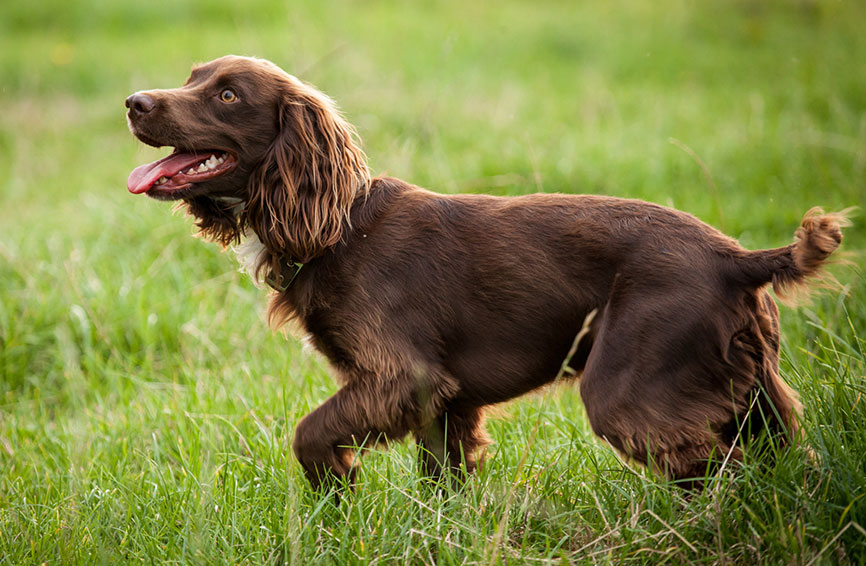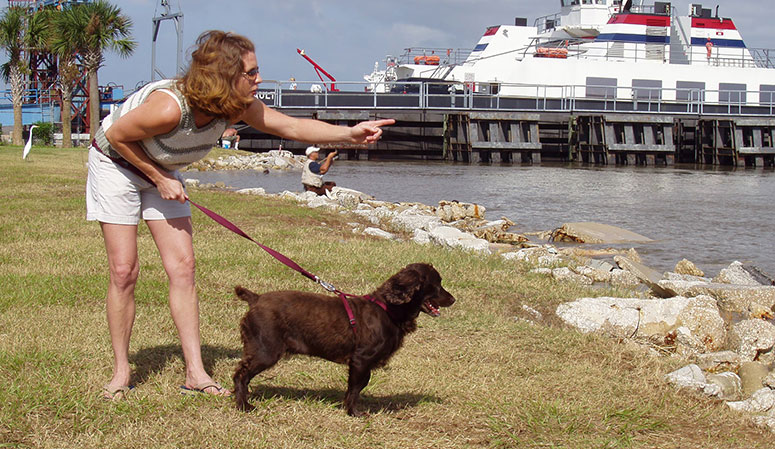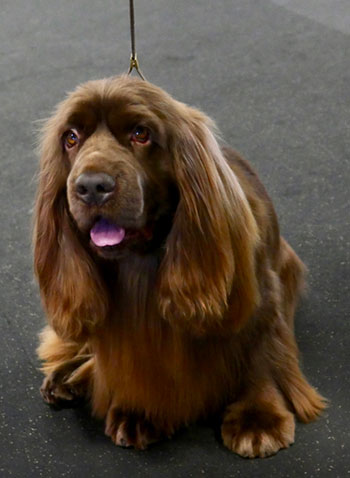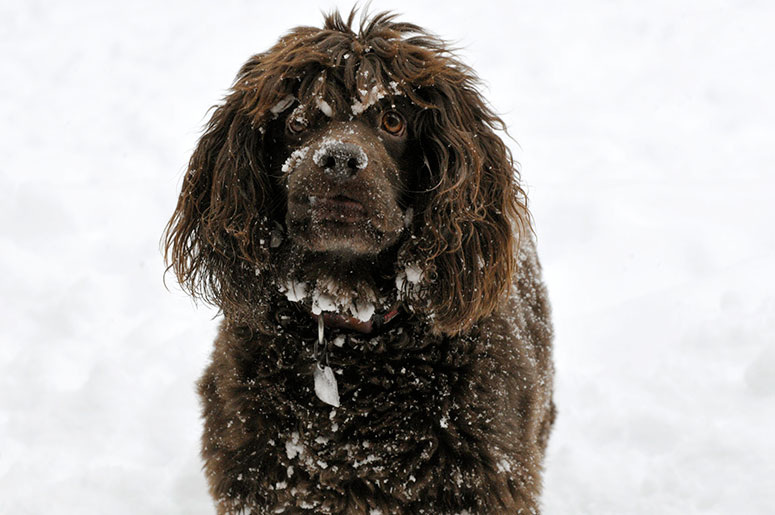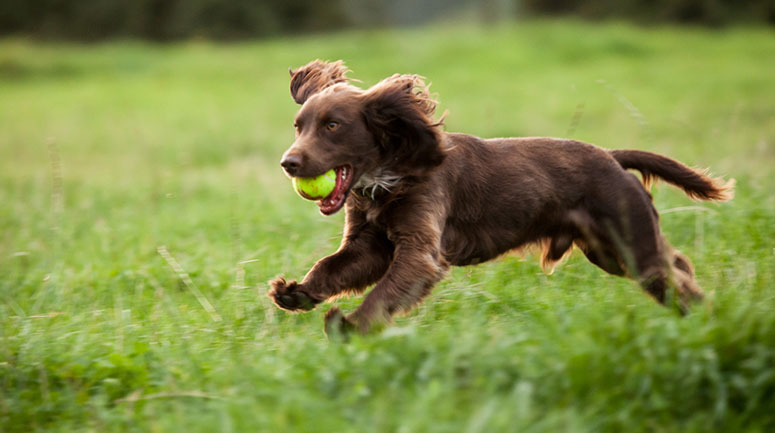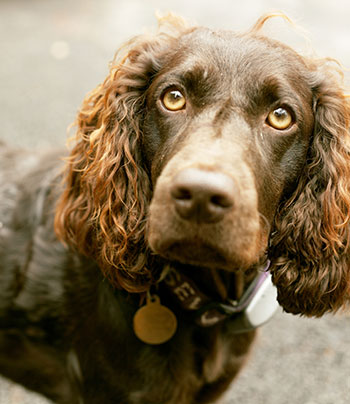Table of Contents
Introduction to Boykin Spaniels
The eager and friendly Boykin spaniel is a Sporting Group dog breed that makes a wonderful companion. These dogs love being around people and are affectionate, patient, and gentle. They get along well with dogs and children, yet they also have excellent hunting skills because of their breeding and genetics. However, these medium-built dogs are full of energy and require family members who love to get out for exercise and play.
To learn more about your new potential family pet, read this Healthy Paws breed guide that covers the dog’s size, temperament, health issues, care, and insurance needs.
Size of Boykin Spaniels
Adult male Boykin spaniels are 30 to 40 pounds and 15.5 to 18 inches tall. Females weigh 25 to 35 pounds and stand 14 to 16.5 inches tall. Although these dogs reach their adult height by about seven to eight months of age, they continue gaining weight through muscle and fat until 14 to 16 months.
Here’s how big you can expect your Boykin spaniel to get as the dog grows from puppyhood to adulthood:
| Weight Chart | 6 months | 12 months | 18 months |
| Average male Boykin spaniels | 25 lbs. | 30 lbs. | 35 lbs. |
| Average female Boykin spaniels | 20 lbs. | 25 lbs. | 30 lbs. |
Characteristics of Boykin Spaniels
Boykin spaniels are confident and adaptable dogs that enjoy people and have a lot of personality and charm. They thrive on human companionship and need family members devoted to spending time with them. This breed generally gets along well with other pets, making them an excellent option for multi-pet households. Boykin spaniels love being active and excel in various sports, including water retrieving, swimming, and hunting. These dogs need physical and mental stimulation; without it, they may be challenging to live with.
As you get to know a Boykin spaniel’s personality, here’s what you can expect based on the breed characteristics:
| Breed Characteristic | Level (High, Medium, Low) |
| Affectionate with People | High |
| Good with Kids | High |
| Good with Pets | High |
| Need for Exercise | Medium |
| Energy Level | High |
| Intelligence Level | High |
| Able to Be Trained | High |
| Amount of Barking | Medium |
| Amount of Shedding | Medium |
History of Boykin Spaniels
The Boykin spaniel is the official state dog of South Carolina and was initially bred in this southeast U.S. state. They are sometimes called “marsh spaniels” and “swamp dogs” because of their origin, and former U.S. president Jimmy Carter had several dogs of this breed over the years.
The dog is named after a small community in South Carolina that has only been home to 100 to 200 people. Boykin, South Carolina was named after a founding resident named Lemuel Whitaker Boykin. Historical records show that around the year 1900, a man named Alexander White found a spaniel outside his Spartanburg, South Carolina church and began hunting with him. Mr. Boykin was his hunting partner and started a new breeding program using the spaniel dog. By combining Chesapeake Bay retrievers, cockers, English springers, and American water spaniels, he developed the breed we know today as the Boykin spaniel. Bird hunters in other parts of the country learned about the Boykin spaniel and discovered the dogs were energetic in fields, able to work on land and water, and sweet companions in the household, too. September 1 is designated Boykin Spaniel Day, and the American Kennel Club first recognized the breed in 2009.
Boykin Spaniel Standard Information
The general appearance of a Boykin spaniel includes being well-muscled, having a docked tail, and having great agility. These moderately-boned dogs are smaller and weigh less than many other sporting dogs, giving them distinct advantages for hunting and sports.
Here is an overview of the breed standard information for Boykin spaniels:
Head:
- Proportional to the size of the dog
- Alert, eager, and self-confident expression
- Yellow, amber, or brown eyes
- Pendulous ears that are set higher when alert
- Muzzle approximately the same length as the skull
- Nose is fully pigmented and dark liver in color
- Scissors bite preferred but level bite is acceptable
Neck, Topline, Body:
- Moderately long and muscular neck
- Straight strong, and level topline
- Sturdy body that is not too compact and not square
- Tail is docked to three to five inches when mature
Forequarters:
- Sloping, muscular, and clean shoulders
- Medium length legs that are straight and well-boned
- Pasterns are strong
- Feet are round and compact
- Dewclaws should be removed
Hindquarters:
- Well-developed hips and thighs
- Hocks are well let down
- Pasterns are relatively short
- Feet are the same as with forequarters
Coat:
- Slightly wavy to curly coat of a medium length
- Considered to be a “wash and wear” dog
- Coat can be trimmed but never shaved
- Honorable field scars are acceptable
Color:
- Solid liver color and a deep reddish brown
- Various shades of light to very dark chocolate brown
- A small amount of white on the chest is acceptable
- Sun bleaching is acceptable
Gait:
- Effortless gait with good reach
- A long, forward stride with no side-winding
- Eager and energetic in the field, yet controlled during a hunt
Caring for Boykin Spaniels
Despite the Boykin spaniel’s moderate size, this breed does not do very well in apartments. These energetic dogs need room to move around and plenty of time outdoors.
Here are some general tips for taking the best care of a Boykin spaniel:
Best Living Environments:
- Not good apartment dogs
- Best with active people who enjoy outdoor activities
- Households with people around most of the time
- Moderately tolerant of warm and cool weather
Type of Exercise:
- 60 to 120 minutes of exercise per day
- Long walks and play sessions
- Swimming
- Hiking
- Running with a family member or alongside a bike
- May become destructive if not receiving enough exercise and activity
Mental Enrichment:
- Obedience training
- Tracking, agility, rally, and field events
- Nose work
Training Strategies:
- Early socialization and puppy training classes
- Generally easy to train
- Smart and eager-to-please dogs that love to learn
- Challenge the dog with learning new skills and tricks
- Use positive reinforcement and treats during training
Grooming Tips:
- Minimal maintenance for the wavy coat
- Brush weekly to remove loose hair and dirt
- Inspect the coat for matting and tangles
- Bathe only occasionally
- Trim nails regularly
Common Health Problems of Boykin Spaniels
The average life expectancy of Boykin spaniels is 10 to 15 years. They are generally healthy dogs but should also be checked by breeders for certain health conditions because of their breeding. For example, Boykin spaniels are prone to ear infections, hip dysplasia, cataracts, and exercise-induced collapse. The national breed club for Boykin spaniels recommends that the dogs have the following health tests: OFA radiographs of the patellas and hips; DNA testing for exercise-induced collapse, collie eye anomaly, and degenerative myelopathy; and an ophthalmologist evaluation.
These are some of the most common health issues that arise with Boykin spaniels:
- Patellar luxation
- Hip dysplasia
- Eye issues, including progressive retinal atrophy, glaucoma, and cataracts
- Skin allergies
- Ear infections
- Pulmonic stenosis (heart abnormality)
- Exercise-induced collapse
Diet and Nutrition for Boykin Spaniels
A fully grown Boykin spaniel will need about 2.5 cups of dry dog food daily. Some recommended dog food brands for this breed include The Farmer’s Dog fresh recipes, Zignature Salmon Formula for a wet dog food option, and American Journey Limited Ingredient Salmon & Sweet Potato for a dry dog food.
Where to Adopt or Purchase Boykin Spaniels
Since 1977, the Boykin Spaniel Society has been the national breed club for this type of dog and provided information about litter registrations, breed events, regional clubs, and a breeder directory. You can also contact Boykin Spaniel Rescue, Inc. to adopt a dog of this breed, rehome your dog, or volunteer to help dogs in need. Depending on where you live, there may be more regionally specific organizations to contact, such as Hunters Rest Boykin Spaniels in Tennessee and Operation Little Brown Dog in Texas.
Related Breeds
There are multiple kinds of spaniel dog breeds, which you may be interested to learn more about before deciding to bring a new pet into your home. Consider these dog breeds as well if you are interested in the Boykin spaniel:
- Cocker spaniel
- Springer spaniel
- English springer spaniel
- Deutscher wachtelhund
- American water spaniel
Pet Insurance for Boykin Spaniels
One of the best things you can do to take care of your Boykin spaniel is to sign your pup up for pet insurance through Healthy Paws. Healthy Paws offers dog insurance plans for Boykin spaniels that covers illnesses, accidents, hereditary and congenital conditions, cancer, chronic conditions, emergency and specialty hospitals, hip dysplasia, and alternate care. Whenever your dog isn’t feeling well, our easy-to-understand pet insurance plan allows you to focus on your Boykin spaniel getting better instead of the high vet treatment costs.
Please tell us a few details about your Boykin spaniel to get your online pet insurance quote today.
